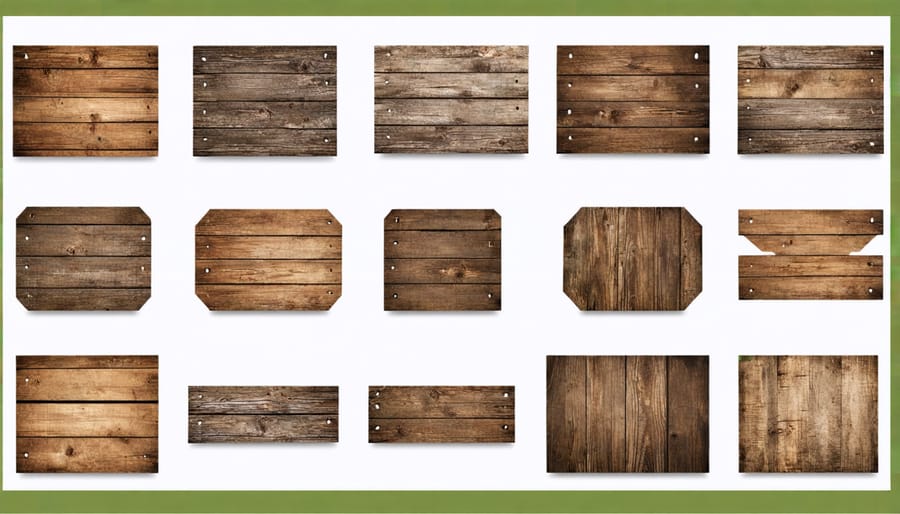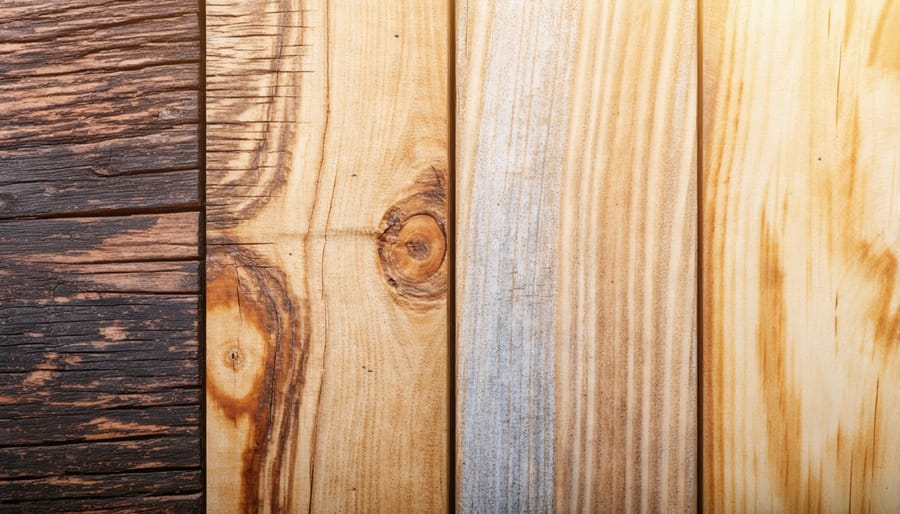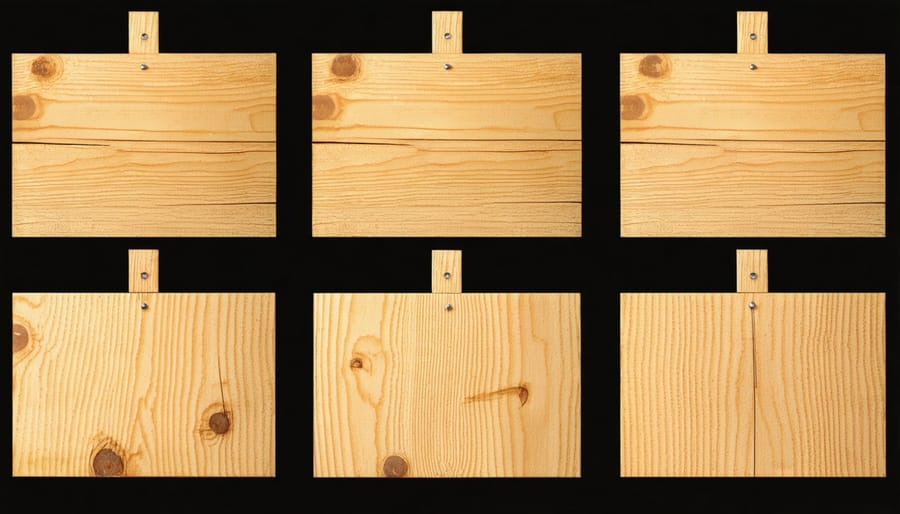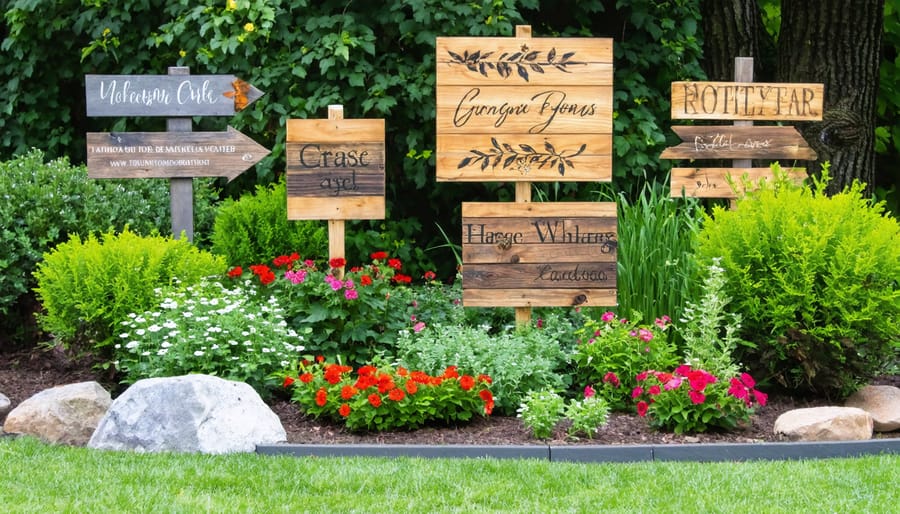Transform your home’s exterior with custom wood signs that tell your unique story and personalize your outdoor space with lasting charm. Whether welcoming guests with an elegant family name plaque or marking your garden with whimsical quotes, outdoor personalized wood signs combine rustic warmth with personal expression.
Crafted from durable hardwoods like cedar, teak, or pressure-treated pine, these distinctive markers weather beautifully while maintaining their character through seasons of sun, rain, and snow. Modern weatherproofing techniques and deep-carved lettering ensure your message stands proud for years, while customization options span from laser-etched designs to hand-painted artwork.
Beyond mere decoration, these wooden statements serve as functional art pieces that elevate curb appeal, guide visitors, and create meaningful focal points throughout your landscape. From grand entrance signs to intimate garden markers, each piece can be tailored to reflect your style while withstanding outdoor elements with grace.
Through thoughtful design and proper material selection, your personalized wood sign becomes more than just a marker—it’s an enduring expression of home that grows more characterful with each passing season.
Creating Impact with Personalized Wood Signs
Popular Design Styles
When it comes to outdoor personalized wood signs, several design styles can help create outdoor focal points that perfectly match your home’s aesthetic. Rustic designs embrace natural wood grain and weathered finishes, often featuring distressed textures and earthy tones that give your space a warm, lived-in feel. These signs frequently incorporate hand-painted elements and rough-hewn edges that complement garden settings beautifully.
Modern designs take a minimalist approach, featuring clean lines, bold typography, and geometric shapes. These signs often utilize contrasting colors and sleek finishes, making them perfect for contemporary homes and urban gardens. Farmhouse-style signs blend rustic charm with simple elegance, typically showcasing white-washed backgrounds with black lettering and decorative borders that add a touch of countryside charm.
For those preferring a more sophisticated look, contemporary designs offer a perfect balance between modern and traditional elements. These signs might feature mixed materials, such as combining wood with metal accents, or incorporate innovative lighting elements for added drama. Whatever style you choose, the key is selecting a design that reflects your personal taste while complementing your home’s exterior architecture.

Strategic Placement Ideas
The perfect placement of your personalized wood sign can dramatically enhance your home’s curb appeal. For entryway signs, position them at eye level, roughly 5-6 feet from the ground, ensuring they’re easily visible from your walkway. Consider complementing your sign with strategic outdoor lighting to create an inviting ambiance after sunset.
For larger property signs, place them near the entrance of your driveway, angled slightly toward approaching traffic for maximum visibility. Garden signs work best when nestled among landscaping elements, creating natural focal points that draw the eye through your outdoor space.
When mounting signs on your house, align them with architectural features like porch columns or garage doors. For multi-piece designs, maintain consistent spacing between elements and ensure they follow your home’s natural lines.
Remember to account for weather exposure – position signs where they won’t be completely hidden by growing shrubs or constantly pelted by sprinklers. A slight forward tilt can help prevent water accumulation and extend your sign’s lifespan.
Materials and Durability Factors
Best Woods for Outdoor Signs
When it comes to weather-resistant wood options for your outdoor sign, some species naturally outperform others. Cedar stands as a top contender, thanks to its natural resistance to decay and insects, plus its ability to withstand various weather conditions without warping. It’s also lightweight and accepts stains beautifully, making it perfect for detailed personalization.
Pine offers an economical choice that’s widely available and easy to work with. While not as naturally weather-resistant as cedar, pressure-treated pine can last for years when properly sealed and maintained. Its soft nature makes it ideal for carving and routing, though it may require more frequent maintenance.
Oak brings incredible durability and a distinctive grain pattern that adds character to any sign. Its density makes it highly resistant to wear and tear, though this same quality can make it challenging to carve intricate details. White oak, in particular, excels in outdoor applications due to its superior moisture resistance.
For those seeking premium options, teak and cypress deserve consideration. Teak’s natural oils make it exceptionally weather-resistant, while cypress contains chemical compounds that naturally repel insects. Both woods age gracefully, developing a sophisticated silver-gray patina over time.
Remember that regardless of your wood choice, proper sealing and regular maintenance will significantly extend your sign’s lifespan and keep it looking fresh for years to come.

Weather Protection Tips
Protecting your personalized wood sign from the elements is crucial for maintaining its beauty and extending its lifespan. Start by applying a high-quality exterior sealant specifically designed for outdoor wood. Two to three coats of marine-grade polyurethane or spar urethane will create a robust barrier against moisture and UV rays, while still allowing the wood’s natural beauty to shine through.
Consider using a pre-treatment wood preservative before sealing, especially if your sign will be exposed to heavy rainfall or intense sunlight. These preservatives contain chemicals that prevent rot and fungal growth, giving your sign extra protection from the inside out.
For signs mounted directly on posts or walls, ensure proper drainage by installing them with a slight forward tilt of about 5 degrees. This prevents water from pooling on the surface and seeping into the wood. Adding small rubber spacers between the sign and mounting surface creates additional airflow, reducing moisture buildup.
Regular maintenance is key to long-term protection. Every six months, inspect your sign for any signs of wear or water damage. Touch up the sealant as needed, and clean the surface gently with a soft brush and mild soap solution. During extreme weather conditions, consider using a protective cover or bringing smaller signs indoors.
For coastal areas or regions with harsh weather, opt for additional protection by adding copper or zinc caps along the top edge of your sign. These metal strips act as natural water diverters while developing an attractive patina over time.
Personalization Options
Text and Typography Choices
When it comes to outdoor wood signs, choosing the right typography can make or break your design. Classic serif fonts like Times New Roman and Georgia offer timeless elegance, while sans-serif options such as Arial and Montserrat provide modern clarity that’s easy to read from a distance. For that rustic, handcrafted feel, consider playful fonts like Rustico or Mountain Bridge.
Size matters significantly in outdoor signage. A good rule of thumb is to ensure letters are at least 1 inch tall for every 10 feet of viewing distance. For house numbers or names visible from the street, aim for characters at least 4 inches tall. Remember, wood grain can affect letter clarity, so slightly larger sizes are better than going too small.
Layout-wise, keep things balanced and straightforward. Center alignment works beautifully for most designs, while left alignment offers a contemporary edge. Allow for adequate spacing between letters (kerning) and lines (leading) – about 20-30% of the letter height is ideal for outdoor visibility.
For maximum durability and readability, stick to bold or medium-weight fonts. Avoid ultra-thin letterforms that might get lost in the wood grain or deteriorate quickly. If you’re including multiple text elements, create hierarchy through size variation – make the main text 30-50% larger than secondary information.
Dark letters on light wood or vice versa provide the best contrast for outdoor visibility. Consider how shadows and sunlight will play across your sign throughout the day when finalizing your typography choices.
Decorative Elements
Transform your wooden sign from simple to stunning with decorative elements that truly make it pop. Graphics are a fantastic way to add personality – consider incorporating nature-inspired designs like leaves, flowers, or birds for garden signs, or nautical elements like anchors and waves for coastal homes. Family crests, geometric patterns, and custom illustrations can also make your sign uniquely yours.
Borders add a professional finishing touch and help frame your message beautifully. Classic options include rope-style carved edges, simple raised borders, or intricate Celtic knot patterns. For a more rustic look, consider leaving the natural edge of the wood exposed on one side while finishing the others with a clean border.
Artistic touches can elevate your sign through various techniques. Wood burning creates dramatic contrast and a timeless appearance, while relief carving adds depth and dimension. Consider incorporating metal accents, such as copper or brass corners, for an elegant touch. Paint effects like distressing, color washing, or hand-painted details can bring your design to life.
Don’t forget about texture – combining smooth finished areas with deliberately rough sections can create interesting visual contrast. Small decorative elements like carved stars, hearts, or other motifs can be scattered throughout the design to fill empty spaces and add charm. Remember, less is often more – choose decorative elements that complement rather than overwhelm your sign’s main message.
DIY vs. Professional Creation
DIY Project Guide
Creating your own personalized wood sign is a rewarding project that can be completed in a weekend. You’ll need basic tools including a saw (hand or power), sandpaper (medium and fine grit), wood stain or paint, brushes, a pencil, and your choice of lettering tools. For the wood, select weather-resistant options like cedar, redwood, or pressure-treated pine.
Start by cutting your wood to size, ensuring clean, straight edges. Sand all surfaces thoroughly, beginning with medium-grit sandpaper and finishing with fine-grit for a smooth surface. Remember to sand with the grain to avoid scratches.
For lettering, you have several options. Beginners might prefer using stencils or transfer paper to outline their design. More experienced crafters can try freehand painting or wood burning. If you’re using stencils, secure them firmly with painter’s tape and use a foam brush to dab paint within the letters, preventing bleeding under the stencil.
Before adding your design, decide whether you want to stain or paint the background. Apply your chosen finish evenly and allow it to dry completely. For extra protection against the elements, seal your completed sign with two coats of exterior-grade polyurethane.
Consider adding decorative elements like borders, symbols, or house numbers to make your sign truly unique. Remember to pre-drill holes for hanging hardware before applying any finishes, and use rust-resistant brackets or hooks for mounting.
Take your time with each step, and don’t rush the drying process between coats. Your patience will be rewarded with a beautiful, personalized sign that will welcome visitors to your home for years to come.

Working with Professional Craftsmen
Working with a professional craftsman to create your personalized outdoor wood sign can be an exciting and rewarding experience. To get the best results, start by researching local woodworkers who specialize in custom signage. Look through their portfolios and read customer reviews to ensure their style matches your vision.
When reaching out to craftsmen, be prepared with specific details about your project. This includes your desired dimensions, wood type preference, and any particular design elements you’d like to incorporate. Many professionals appreciate reference photos or sketches to better understand your vision.
Expect the consultation process to involve discussions about wood selection, finishing techniques, and weather protection options. A good craftsman will guide you through these choices, explaining the pros and cons of each option for your specific situation. They should also provide insight into how different woods weather in your climate and recommend appropriate protective treatments.
Timeline expectations typically range from 2-4 weeks, depending on the complexity of your design and the craftsman’s current workload. Most professionals will require a deposit upfront, usually around 50% of the total cost, with the balance due upon completion.
During the creation process, don’t hesitate to ask for progress photos or updates. Professional craftsmen usually welcome client involvement and want to ensure your complete satisfaction. Before finalizing the project, discuss installation options – some craftsmen offer installation services, while others will provide detailed mounting instructions for DIY installation.
Remember to inquire about care instructions and maintenance recommendations to ensure your custom sign remains beautiful for years to come. A reputable craftsman will gladly provide this information and may even offer touch-up services if needed in the future.
A personalized outdoor wood sign is more than just a decorative element – it’s a statement piece that transforms your outdoor space into a truly unique and welcoming environment. Whether you’re marking your family homestead, creating a charming garden marker, or establishing your business presence, these custom pieces bring character and warmth to any exterior setting.
Throughout this guide, we’ve explored the various materials, designs, and techniques that make outdoor wood signs both beautiful and durable. From rustic cedar to weather-resistant pine, each wood type offers its own distinct charm and practical benefits. The possibilities for customization are endless, allowing you to create something that perfectly reflects your style and meets your specific needs.
Remember that creating your own personalized wood sign can be both a rewarding DIY project and a meaningful investment in your property. Whether you choose to craft it yourself or work with a professional artisan, the end result will be a lasting piece that adds value and personality to your outdoor space.
Ready to start your own wood sign project? Take inspiration from the designs we’ve discussed, consider your space and style preferences, and don’t be afraid to get creative. Your perfect outdoor wood sign awaits – one that will welcome guests, showcase your personality, and stand the test of time while telling your unique story.










